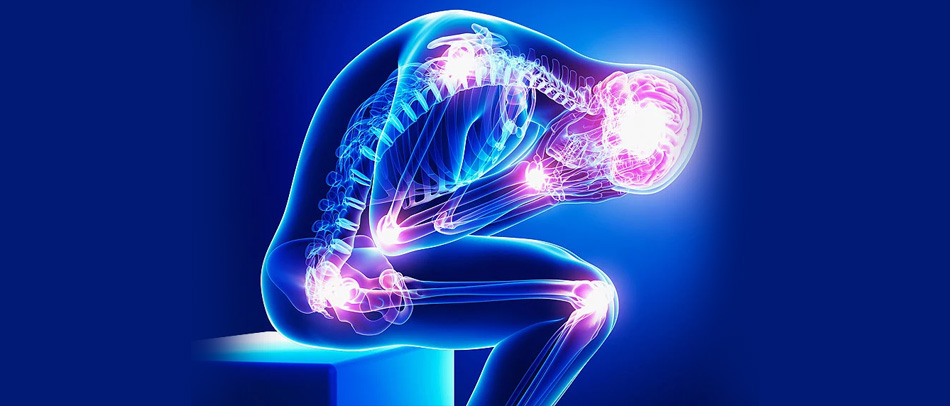Explore this page:

What is chronic pain?
Chronic pain is often defined as any pain lasting more than 12 weeks and can range in intensity from mild to severe. Most types of pain resolve after the physical injury heals. However, chronic pain can last for months and even years after the physical injury heals. In fact, chronic pain can even occur when there’s no known trigger for the pain.
Chronic pain has reached epidemic proportions in Canada and the US, with millions of people suffering from it on a daily basis. Since chronic pain is psychologically difficult to endure, it can often trigger anxiety and depression. This debilitating condition is often associated with other health problems, including fatigue; sleep disturbance, decreased appetite, and mood changes, making chronic migraine headaches treatment essential for many.
What are the causes of chronic pain?
Chronic pain can stem from various conditions that often require the expertise of a chronic pain specialist. It may develop from physical injuries like a back sprain or from ongoing illnesses. In some cases, the exact cause of chronic pain cannot be determined. This type of pain can alter the way neurons (nerve cells in the brain and spinal cord) transmit and process sensory information, leading to an increased sensitivity to pain signals..
Chronic pain is often associated with conditions that cause long-lasting pain. These include the following:
Osteoarthritis
This is the most common form of arthritis, affecting millions of individuals worldwide. In osteoarthritis, the protective cartilage on the ends of bones wears down due to “wear and tear.” This causes increased friction, and pain and inflammation at joints. Although osteoarthritis can damage any joint in your body, the disorder most commonly affects joints in your hands, knees, hips and spine.
Neck Pain
Chronic neck pain is a persistent discomfort or aching sensation in the neck area that lasts for more than three months. This type of pain can be continuous or intermittent and is often associated with stiffness, muscle tightness, and a limited range of motion. Chronic neck pain can result from various underlying causes, including degenerative disc disease, herniated discs, muscle strains, previous injuries, osteoarthritis, nerve compression, or conditions like fibromyalgia. It can significantly impact daily activities and overall quality of life, making it essential to seek medical evaluation and appropriate treatment to manage and alleviate the symptoms.
Headache Migraine
Chronic headache migraine is a debilitating condition characterized by frequent and severe headache attacks occurring on 15 or more days per month, with at least eight of those days featuring migraines. These migraines are often accompanied by intense throbbing or pulsating pain, usually on one side of the head, and can last from a few hours to several days. Symptoms often include nausea, vomiting, and sensitivity to light, sound, or smells.
Chronic headache migraine can significantly disrupt daily life and is often associated with a history of episodic migraines that have become more frequent over time. The exact causes are not fully understood, but factors such as genetics, hormonal changes, stress, sleep disturbances, and certain foods or environmental triggers can contribute to the condition.
Nerve Damage
Nerve damage chronic pain, also known as neuropathic pain, is a persistent pain condition resulting from injury or dysfunction in the nervous system. This type of pain can arise from various sources, including physical trauma, infections, metabolic issues such as diabetes, neurological disorders, or surgical complications. Unlike pain from typical injuries, nerve damage chronic pain is often described as a burning, tingling, or shooting sensation, and it can occur in different parts of the body depending on the affected nerves.
People with nerve damage chronic pain may experience heightened sensitivity to touch (allodynia), where even light contact can cause significant discomfort. They might also suffer from spontaneous pain, which occurs without any apparent trigger, and abnormal sensations (paresthesia), such as numbness or a “pins and needles” feeling.
Cancer
cancer is a prolonged and often intense discomfort that arises due to the cancer itself or as a side effect of cancer treatments. This type of pain can persist for months or even years and can significantly impact a patient’s quality of life. It can result from the tumor pressing on bones, nerves, or other organs, or from treatments such as surgery, chemotherapy, or radiation therapy.
Patients may experience different types of pain depending on the location and nature of the cancer. This pain can be described as dull, aching, sharp, or burning, and it can vary in intensity. In some cases, cancer pain may be constant, while in others, it can be intermittent, flaring up at certain times or during specific activities.
Back pain
Chronic back pain is a persistent or recurrent pain in the back that lasts for three months or longer. This condition can affect the upper, middle, or lower back and is often accompanied by stiffness, reduced flexibility, and difficulty in performing daily activities. Chronic back pain can arise from various causes.
Symptoms of chronic back pain can range from a dull ache to a sharp, stabbing pain. It may be accompanied by stiffness, limited mobility, and sometimes referred pain that radiates to the legs (sciatica) or other parts of the body.
Managing chronic back pain often requires a multidisciplinary approach, including physical therapy, medications, lifestyle modifications, and sometimes surgical intervention.
What are the treatment options for chronic pain?
The goal of chronic pain treatment is to reduce pain and improve function, enabling individuals to resume their daily activities. There are many treatment options for chronic pain, and the appropriate choice usually depends on the underlying cause of the pain. These options include:
Pain medication
Pain medication used to treat chronic pain include non-steroidal anti-inflammatory drugs (NSAIDs), steroids, muscle relaxants, antidepressants with pain-relieving qualities and, in severe cases, opioids. Opioids are powerful painkillers and include drugs such as oxycodone, codeine, fentanyl, and morphine. These drugs provide effective pain relief but are often used as a last resort in chronic pain treatment since they are associated with side effects such as dependence and addiction.
Nerve block
Nerve block treatment for chronic pain and migraine is a medical procedure aimed at relieving persistent pain by disrupting pain signal transmission along specific nerves. This technique involves the injection of a local anesthetic, often combined with steroids or other medications, directly into or around the targeted nerve or group of nerves. The goal is to provide significant pain relief, which can be temporary or long-lasting, depending on the type of nerve block and the medications used.
Steroid injection
This treatment (also called corticosteroid injections) involves the injection of anti-inflammatory medication to treat inflammation and pain. When nerve inflammation is the cause of chronic pain, steroid injections can be delivered directly to the nerves. Steroid injections can also be injected directly into joints to treat conditions such as rheumatoid arthritis and other inflammatory diseases.
Radiofrequency ablation
This technique is a minimally invasive procedure which destroys the nerve fibers carrying pain signals to the brain. The first step of radiofrequency ablation involves the insertion of a needle-like probe to access the targeted nerve tissue. Then an electrical current produced by a radio wave is used to heat up a small area of nerve tissue, decreasing pain signals from that specific nerve. Radiofrequency ablation is used in cases of severe chronic pain and is considered to be relatively safe.
Acupuncture
Acupuncture is an ancient medical practice based on traditional Chinese medicine and is widely used around the world to treat a variety of medical conditions. It is considered to be a complementary medicine practice, and involves the insertion of fine needles through the skin at specific points of the body. One of the main benefits of acupuncture is that it can provide effective results without causing the side effects associated with prescription medication.
The effects of acupuncture can also be long-lasting (for up to 6 months). Numerous scientific research studies have demonstrated that acupuncture can help to alleviate pain, including chronic low-back pain, neck pain, as well as osteoarthritis and knee pain. In addition, studies have also shown that acupuncture can be used to decrease the frequency and even prevent tension headaches and migraines.
Conclusion
Chronic pain is defined as any pain lasting more than 3 months. A chronic headache specialist says, Chronic pain can vary in intensity from mild to severe and can arise from different causes and illnesses, such as physical injury or chronic conditions such as arthritis. It can also affect different parts of the body, including the spine, joints and tissues. There are many available chronic migraine headaches treatment, and they typically selected depending on the underlying condition or cause of pain.






